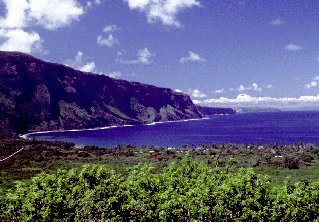Community
This historic theme deals with the social structure of people within the present territory of the United States. Included are the lifeways of various strata of the American people over time. Here are assigned areas depicting in representative fashion significant economic, social, occupational, regional, ethnic, and religious groups.
B. Farming Communities C. Industrial Towns D. Urban Life E. Ethnic Communities (including the Immigration Phenomenon) |
G. Consumer Society of the 20th Century H. Suburban Life I. Domesticity and Family Life J. Occupational and Economic Classes |
Family. Community. Dignity.
 |
These are words with universal meanings, and at Kalaupapa these words describe human experiences, both past and present. Family refers to blood families torn apart by the physical removal of a parent or a child, as well as extended families created through bonding and support for survival. Community refers to the sense of "specialness" that residents of Kalaupapa feel about each other and about the place where they have chosen to live out their lives. Dignity refers to how Kalaupapa residents expect to be treated, and how they carry themselves in the face of societal attitudes towards a frightening illness, Hansen's disease, also known as leprosy.
Two tragedies occurred on the Kalaupapa Peninsula on the north shore of the island of Moloka`i; the first was the removal of indigenous peoples in 1865 and 1895, the second was the forced isolation of sick people to this remote place from 1866 until 1969. The removal of Native Hawaiians from where they had lived for 900 years cut the cultural ties and associations of generations of people with the `aina (land). The establishment of an isolation settlement, first at Kalawao and then at Kalaupapa, tore apart Hawaiian society as the kingdom, and subsequently, the territory of Hawai`i tried to control a feared disease. The impact of broken connections with the `aina and of family members "lost" to Kalaupapa are still felt in Hawai`i today.
Kalaupapa National Historical Park, established in 1980, contains the physical setting for these stories. Within its boundaries are the historic Hansen's disease settlements of Kalaupapa and Kalawao. The community of Kalaupapa, on the leeward side of Kalaupapa Peninsula, is still home for many surviving Hansen's disease patients, whose memories and experiences are cherished values. In Kalawao on the windward side of the peninsula are the churches of Siloama, established in 1866, and Saint Philomena, associated with the work of Father Damien (Joseph De Veuster).
The links below will take you to other NPS units which contain additional information regarding this historical theme. Following that are links to related materials, which will provide more detailed Web sites that discuss selected aspects of this historical theme.
National Park Service units
- Blackstone River Valley National Heritage Corridor*
- Boston African American National Historic Site
- Boston National Historical Park
- Cane River Creole National Historical Park
- Colonial National Historical Park
- Jean Lafitte National Historical Park and Preserve
- Kalaupapa National Historical Park
- Klondike Gold Rush National Historical Park
- Lowell National Historical Park
- Maggie L. Walker National Historic Site
- Manzanar National Historic Site
- Natchez National Historical Park
- Nicodemus National Historic Site
- Pu'uhonua O Honaunau National Historical Park
Related Links